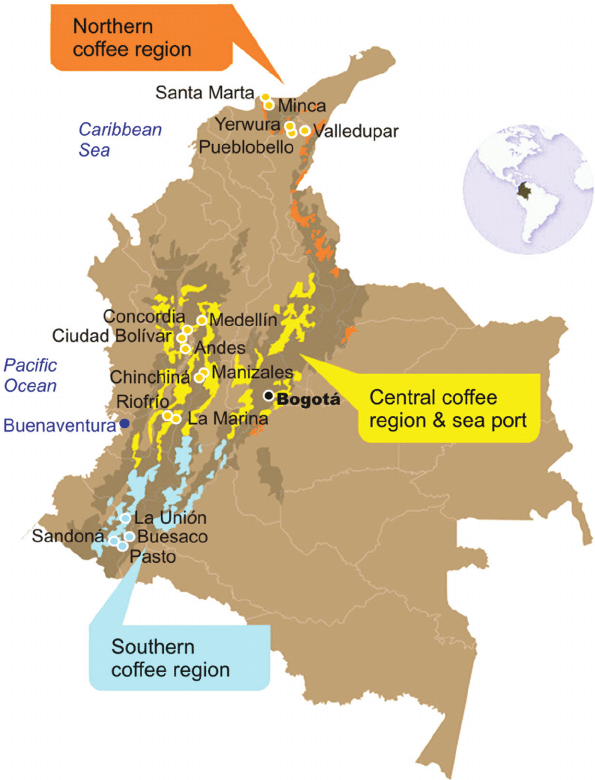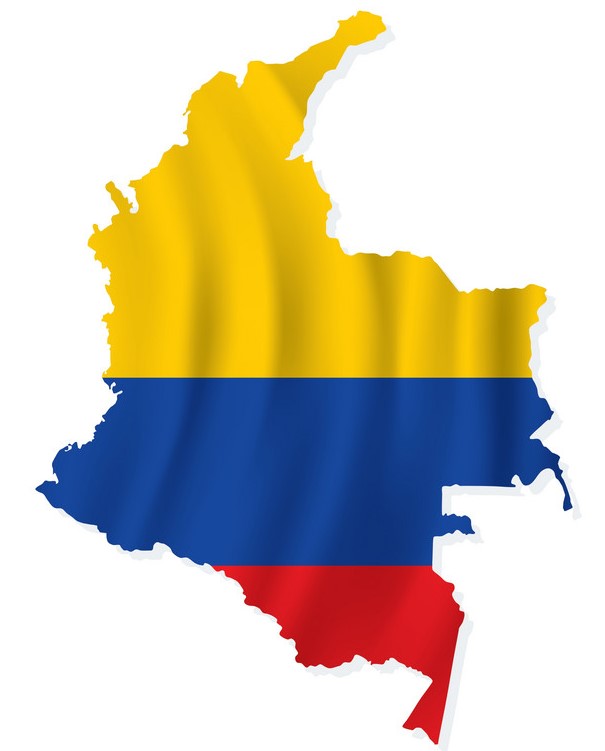Colombian Medellin Excelso (Organic)
About Colombia and its Coffee Production
Coffee production in Colombia has a reputation for producing mild, well-balanced coffee beans. Colombia’s average annual coffee production of 11.5 million bags is the third total highest in the world, after Brazil and Vietnam, though highest in terms of the arabica bean. The beans are exported to the United States, Germany, France, Japan, Australia and Italy.
Most coffee is grown in the Colombian coffee growing axis region, while other regions focus on quality instead of volumes, such as the Sierra Nevada de Santa Marta. In 2007, the European Union granted Colombian coffee a protected designation of origin status. In 2011, UNESCO declared the “Coffee Cultural Landscape” of Colombia, a World Heritage site.
Colombian coffee is often regarded as some of the highest quality coffee in the world. Colombia has traditionally grown arabica beans and its unique geography makes it perfectly suited for producing a delicious, high-quality brew. Colombia’s excellent growing conditions have paired with an aggressive marketing campaign by the National Federation of Coffee Growers (FNC), which has worked since the late 1950s to bring Colombia’s coffee sector to the forefront of international attention.
Colombia has traditionally been second in global coffee production only to Brazil, but has been set back to third by Vietnam’s recent market entry and rapidly expanding production of robusta coffees. Over 500,000 farms, most of them small landholdings of 5 hectares or less are scattered across the zonas cafeterias, some of the most biologically diverse landscapes in the world.
Colombia is bisected by the Andes Mountains which splits into three parallel cordilleras (mountain ranges) as they run south to north. Much of the nation’s coffee is grown in this area. The small nation contains two of South America’s five “biodiversity hotspots”. The Tumbes-Choco hotspot occupies all of Colombia’s coast, while the Tropical Andes hotspot covers nearly all its mountain ranges. In fact, Conservation International calls the Colombian Andes the “richest and most diverse region on earth,” noting that the whole of the tropical Andes chain contains one-sixth of the world’s plant species in only one per cent of its land area.
Where does the Colombian Medellin Excelso (Organic) come from?
Colombian Medellin Excelso Organic & Rainforest Alliance Coffee is grown at elevations of 1000m – 2000m above sea level. The beans are grown in the shade beneath the tropical forest canopy under the banner of Sustainable Agricultural Network. This preserves the natural forests and maintains ecosystems.
This method of growing coffee produces beans of exceptional quality.
Organic coffee is grown without the use of synthetic chemicals or pesticides. Production must be actively organic, including organic composting and environmental protection of watersheds and soils. Natural products and improved crop husbandry are actively encouraged. Production must be actively organic and independently audited for at least two years before certification is granted. Many different certifying agencies exist to process certification at origin and in the US.


What does Organic Mean?
Organic Certified is free of synthetic additives like pesticides, chemical fertilizers and dyes, and must not be processed using industrial solvents, irradiation or genetic engineering
Tasting Notes for Colombian Medellin Excelso (Organic)
| Country | Colombia |
| Screen Size / Grade | SCR 17/18, Organic Certified, Excelso |
| Bean Appearance (green) | Strong green colour, well-formed visual presentation |
| Acidity | Good, pronounced |
| Body | Light-medium |
| Bag Size | 70 kg |
| Harvest Period | 1st Harvest – October to February / 2nd Harvest – April to June |
| Description | [Insert] |
| Tasting Notes | Pure, clean and balanced with a silky, rich mouthfeel and distinctive caramel sweetness. |
| Strength | |
| Processing Method | Washed (Wet Processed) |
| Altitude | 1000 – 2000 MASL |
History of Coffee in Colombia
Coffee in Colombia has about 300 years of history since the Jesuits brought it to the country in the 18th century who arrived with Spanish settlers. The first crops were harvested in the Northeast part of the country, but coffee was quickly adopted across the nation by small, family farms as a local cash crop.
In 1835, the first bags produced in the eastern zone were exported from Cucuta’s customs office. That first shipment of a humble 100 bags of green coffee (around 60kg each) was the first of what would become a major industry. As coffee consumption grew rapidly in The United States, Germany, and France in the mid-1800s, so did Colombia’s coffee production.
Legend has it that the increase of coffee production in Colombia happened thanks to the Jesuit Priest Francisco Romero in a small town in the Department of Santander named Salazar de Las Palmas. When his parishioners confessed, the priest imposed on them sowing coffee as a penance to redeem their sins. Thanks to this, it is said that the coffee production began to expand to other Departments (Provinces), and by 1850, coffee had reached Cundinamarca, Antioquia and Caldas.
By the end of the 19th century, production had increased from 60,000 bags to more than 600,000 bags – it is worth noting that most of this production came from the farms of the largest landowners – and by the end of the 19th century, coffee was already the main foreign exchange export product in Colombia.
The growing industry hit a brief decline in the late 1800s as civil war broke out in the country, called The Thousand Days War. The fighting, along with a lull in international coffee prices, forced many plantation owners to split up farmland among workers, giving locals ownership and autonomy over their own farms.
The transition from the 19th to the 20th century brought a great fall in >the international market prices and therefore a crisis for the landowners, changing the whole picture. This crisis favoured the small producers that were growing, and the west zone became the leader in coffee development.
In the early 1900s, the now peaceful Colombia created a logistics system that enabled rural, small-estate farmers to export their coffee more efficiently. This spurred a new age of growth and gave those newer farmers a way to keep producing.
In 1927 the Federación Nacional de Cafeteros was created, which was responsible for aiding and representing the coffee growers to ensure their rights.
In 1938 the Research Centre, CENICAFE was born, it was responsible for achievements like the “Castillo” variety, resistance to diseases such as rust.
In 1959 two important events occurred: The Character of Juan Valdez was born and the office of Café de Colombia was opened in Tokyo, making Japan today the second consumer of Colombian coffee in the world.
In 1984 the Café de Colombia distinctive hallmark was created, which identifies it in every corner of the world.
Interested in some Colombian Medellin Excelso (Organic)?
Visit our Organic Colombian page or Espresso Bar to buy a bag of our Colombian Medellin Excelso (Organic).
